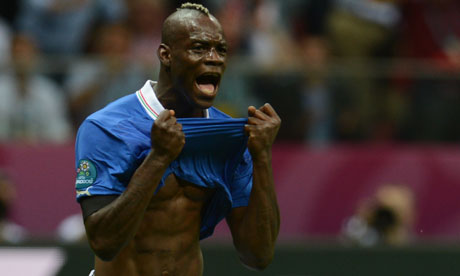I just watched on istream.com in the replay highlights the two wonderful goals that Balotelli scored last night in the Euro semifinal against Germany (Italy 2 Germany 1). Even as he scored twice and celebrated the second goal, throwing a favourite Germany out of the championship, catapulting Italy into the final against Spain, I wondered how the white Europeans would deal with his colour.
And now I am reading this article in the Guardian.

And now I am reading this article in the Guardian.

I quote parts:
As is well known by now, Mario Balotelli was born in Palermo to Ghanaian parents in 1990, who then gave him up for adoption to an Italian family in the north of Italy when he was just two. Under Italian law, however, he was not able to obtain Italian citizenship until he reached the age of 18, despite having been born in Italy and having always lived there.
...... He is black and extremely good at football, and he is a winner. He has played less than 100 league games for his two major clubs (Inter and Manchester City) and won four championships in that time (and four other trophies). Not a bad record for a 21-year-old.
....... Reactions to Balotelli's recent success with the national team have also been illuminating. After the England game, La Gazzetta dello Sport published a bizarre cartoon depicting Mario as King Kong.
....... This morning, Tuttosport did it again. Their headline was a play on words. "Li abbiamo fatti neri" (we made them all black). This phrase literally means "We smashed them", "we humiliated them". But the pun, was linked the word "neri" – blacks.

